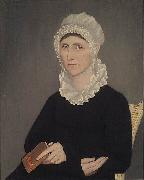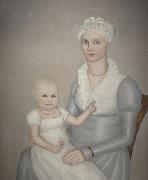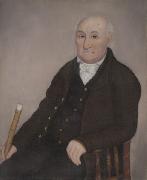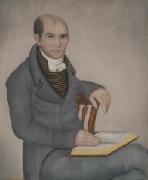Ammi Phillips El petróleo que Pinta la ReproducciónAll Ammi Phillips Oil Paintings(1788-1865), a self-taught New England portrait painter, is regarded as one of the most important folk artists of his era. Phillips was born in Colebrook, Connecticut, and began painting portraits as early as 1810. He worked as an itinerant painter in Connecticut, Massachusetts, and New York for five decades. In 1924, a group of portraits of women, shown leaning forward in three-quarter view and wearing dark dresses, were displayed in an antique show in Kent, Connecticut. The anonymous painter of these strongly colored works, which dated from the 1830s, became known as the "Kent Limner," after the locality where they had come to light. Stylistically distinct from those of the "Kent Limner," a second group of early-19th-century paintings emerged after 1940 in the area near the Connecticut - New York border. Attributed at the time to an unknown "Border Limner," these works, dating from the period 1812 - 1818, were characterized by soft pastel hues, as seen in the portrait of Harriet Leavens, now in the Fogg Art Museum, Harvard University. It was not until 1968 that Ammi Phillips's identity as the painter of both groups of portraits was established. Additional works were identified, showing the artist's transition from the delicate coloration of the Border period to the bold and somber works that followed. |
|||

|
|||
|
|
|||
|
||||||||
| Ammi Phillips (1788-1865), a self-taught New England portrait painter, is regarded as one of the most important folk artists of his era. Phillips was born in Colebrook, Connecticut, and began painting portraits as early as 1810. He worked as an itinerant painter in Connecticut, Massachusetts, and New York for five decades. In 1924, a group of portraits of women, shown leaning forward in three-quarter view and wearing dark dresses, were displayed in an antique show in Kent, Connecticut. The anonymous painter of these strongly colored works, which dated from the 1830s, became known as the "Kent Limner," after the locality where they had come to light. Stylistically distinct from those of the "Kent Limner," a second group of early-19th-century paintings emerged after 1940 in the area near the Connecticut - New York border. Attributed at the time to an unknown "Border Limner," these works, dating from the period 1812 - 1818, were characterized by soft pastel hues, as seen in the portrait of Harriet Leavens, now in the Fogg Art Museum, Harvard University. It was not until 1968 that Ammi Phillips's identity as the painter of both groups of portraits was established. Additional works were identified, showing the artist's transition from the delicate coloration of the Border period to the bold and somber works that followed. |
||||||||
|
|
||||||||
| Pintura identificación:: 71236 Betsey Beckwith between 1815(1815) and 1820(1820) Oil on canvas 77.4 x 62.4 cm (30.47 x 24.57 in) |
||||||||
|
|
||||||||
| Pintura identificación:: 71465 Jeannette Woolley, later Mrs. John Vincent Storm between 1835(1835) and 1845(1845) Oil on canvas 83.8 x 71 cm (32.99 x 27.95 in) |
||||||||
|
|
||||||||
| Pintura identificación:: 72968 Mrs. Wilbur Sherman and daughter Sarah "Mrs. Wilbur (Sarah 'Sally' Stearns) Sherman (1789-1845) and daughter Sarah (1814-1872)," oil on canvas, by the American artist Ammi Phillips. 36 in. x 30 in. Yale University Art Gallery, the Teresa and H. John Heinz III Charitable Lead Trust. Courtesy of Yale University, New Haven, Conn. cjr |
||||||||
|
|
||||||||
| Pintura identificación:: 72987 Caleb Sherman "Caleb Sherman (1736-1822)," oil on canvas, by the American artist Ammi Phillips. 36 in. x 30 in. Yale University Art Gallery, the Teresa and H. John Heinz III Charitable Lead Trust. Courtesy of Yale University, New Haven, Conn. cjr |
||||||||
|
|
||||||||
| Pintura identificación:: 72989 The Teresa and H. John Heinz III Charitable Lead Trust The Teresa and H. John Heinz III Charitable Lead Trust cjr |
||||||||
|
|
||||||||
| ARTISTA PREVIO PROXIMO ARTISTA | ||||||||
|
|
||||||||
|
Ammi Phillips (1788-1865), a self-taught New England portrait painter, is regarded as one of the most important folk artists of his era. Phillips was born in Colebrook, Connecticut, and began painting portraits as early as 1810. He worked as an itinerant painter in Connecticut, Massachusetts, and New York for five decades. In 1924, a group of portraits of women, shown leaning forward in three-quarter view and wearing dark dresses, were displayed in an antique show in Kent, Connecticut. The anonymous painter of these strongly colored works, which dated from the 1830s, became known as the "Kent Limner," after the locality where they had come to light. Stylistically distinct from those of the "Kent Limner," a second group of early-19th-century paintings emerged after 1940 in the area near the Connecticut - New York border. Attributed at the time to an unknown "Border Limner," these works, dating from the period 1812 - 1818, were characterized by soft pastel hues, as seen in the portrait of Harriet Leavens, now in the Fogg Art Museum, Harvard University. It was not until 1968 that Ammi Phillips's identity as the painter of both groups of portraits was established. Additional works were identified, showing the artist's transition from the delicate coloration of the Border period to the bold and somber works that followed. |
||||||||
|
|
||||||||
|
CONTACTE EEUU |










